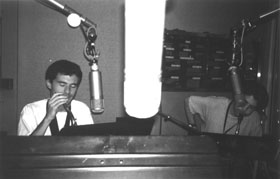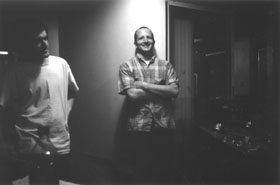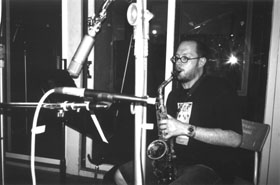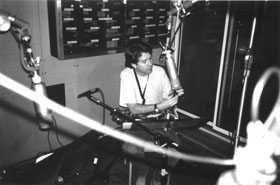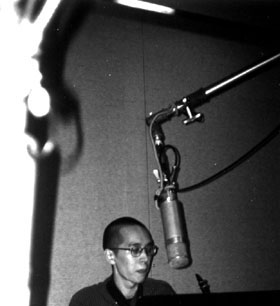|
JAMES
FEI Alto Quartets
[Organized
Sound Recordings 4]
RELEASED: October 2004
1. Study
II [Scream] (1999) 3’08”
2. Study IV [Flutter] (2001) 4’02”
3. for
four alto saxophones (4/1998) 7’49”
4. Horizontal-Vertical (1999) 6’17”
5. Work
for crippled reeds (1999) 14’57”
6. for four alto saxophones (7/1998 part II) 8’11”
7. Study
III [Saliva] (2001) 3’09”
Click
on titles for MP3 excerpts.
Available at: organizedsoundrecordings.bandcamp.com
ADDITIONAL
NOTES:
Study II [scream] organizes screams
through the saxophone by specifying exact rhythms and the approximate
register of the noise spectra. The rapid intercutting of the screams
is partly inspired by the detailed splicing of early musique concrète
pieces such as Cage’s Williams Mix, as well as structural
films (e.g. Paul Sharits) and the metrical films of Peter Kubelka.
Study IV [flutter] is entirely performed
with various types of flutter tonguing. The piece is partly derived
from my chamber work, The Dots and the Lines, where pointillistic
constellations are isolated with extensive silence.
for four alto saxophones (4.98) consists
of two parts. The first comprises of a series of staggered chords,
where each performer plays slightly before or after the actual pulse;
the second part is on the other hand entirely unsynchronized, with
independent swells that recall the envelope generated by backwards
tape.
Horizontal–Vertical attempts to
create a suspended sense of time (i.e. a vertical one) through dense
polyphony. Because the material is limited to a small gamut of gestures
and pitch/rhythmic units, the listener becomes gradually familiar
with the static elements despite the complexity and sonic saturation.
In Work, the reeds of the saxophones
are altered with various cuts, no longer producing predictable tones
but colored noise with intermittent response. The sheer effort and
physicality of performance, with their byproducts such as the sounds
of breath and saliva, are brought to the surface where they are
usually considered undesirable.
for four alto saxophones (7.98) part II mixes bursts of static
improvisation with short tones. The events are organized in three
rhythmic series, which are taken from my earlier work, for orchestra
(3.98).
Study III [saliva]—by tilting
the saxophone upwards, a pool of saliva is retained in the mouthpiece,
breaking up the reed’s normal mode of vibration. The bubbling
liquid induces sweeps through the overtones in addition to multiple
rhythms (for the high and low “bubbles”)—the performers
circular breathe throughout and make no articulations other than
slow shifts in fundamental pitch. Dedicated to Sigurd Rascher.
RECORDING
DATA :
Tracks 1, 2, 4, 5 & 7 recorded on July 21, 2001 at Sorcerer
Sound (New York) by Jon Rosenberg, assited by Chris Palmisano.
Each alto saxophone was mic'd with a Neuman U47 or U48 in cardiod.
A pair of B&K 4007 omnis were used for room ambience. Some plate
reverb was added from an EMT 140. Mixed live to two track on Sorcerer's
custom console to DAT (multi-track ADAT was ran as well but not
used in the release).
Track 3 recorded live in World Music Hall (Middletown, Connecticut)
on April 22, 1998 and track 6 recorded live in Greenwich House (New
York City) on October 2, 1998. Both engineered by James Fei with
a Crown SASS-P Mk II stereo mic direct to DAT.
Mastered at Organized Sound by James Fei.
OTHER
WORKS FOR THE ALTO QUARTET (not included on the CD) :
FOR FOUR ALTO SAXOPHONES (7.98) PART I: I have, unfortunately, not
been able to capture this work faithfully on recordings. The piece
consists entirely of extreme high tones which cause acoustic interference,
producing difference and summation tones in additional to rapid
spatial movement.
STUDY I (HARMONY): Each member of the quartet chooses a bebop/hardbop
tune, which is played simultaneously with no synchronization. Featured
as an encore on the Live in Taipei DVD.
INFRA–SLIM: The title is borrowed from Duchamp: "When
the tobacco smoke also smells of the mouth which exhales it, the
two odors are married by infra-slim." The hour-long work is
concerned with the threshold of audibility, where the four performers
attempt to play as quietly as possible, the resultant tones falling
indeterminately in as many discrete levels (ppppppp, pppppp,
ppppp...) as the one we are accustomed to (ppp, pp, p...).
A recording of Infra-Slim is planned for future release on Organized
Sound.
FAKTURA: This is an offshoot of the quartet, scored for two alto
saxophones and idling electronics. First performed at the Roulette.
MP3 excerpt: Faktura
(recorded at Roulette by Jim Staley with two Klaus Heyne-modified
U87's and a pair of Schoeps).
UNRELEASED LIVE RECORDINGS:
Study
I [Scream]:
Live at Roulette (NYC) 30 III 02. 2'45" 3.7mb
for
four alto saxophones (7.98) part II:
Live at Brecht Forum
9 III 01 (NYC). 6'03" 8.3mb
|
